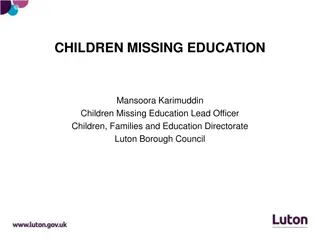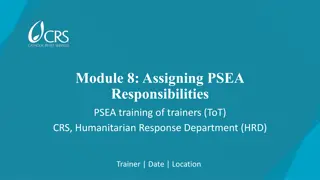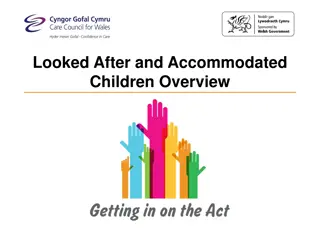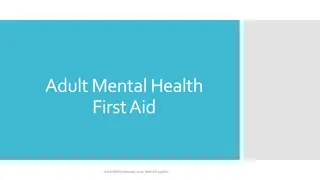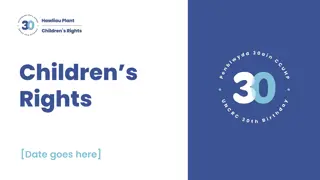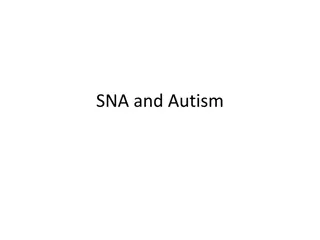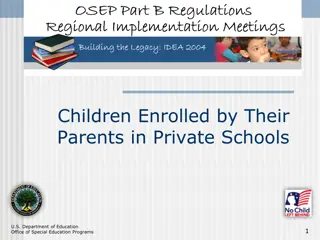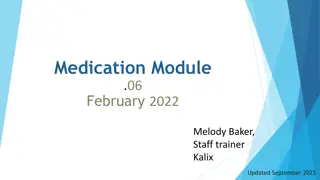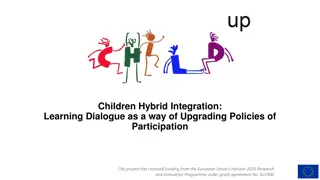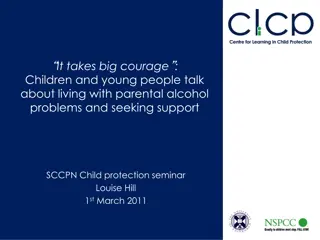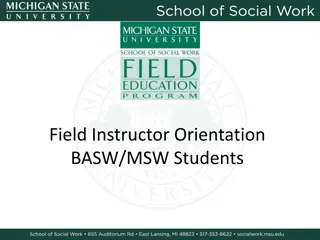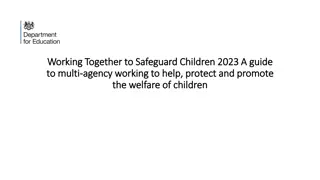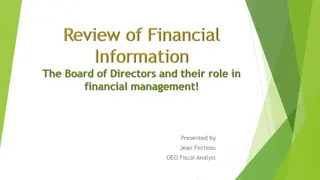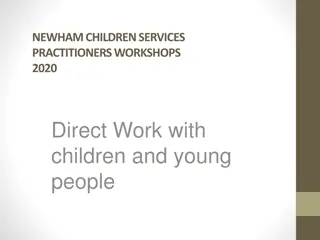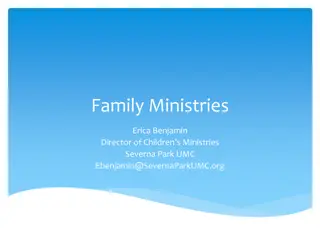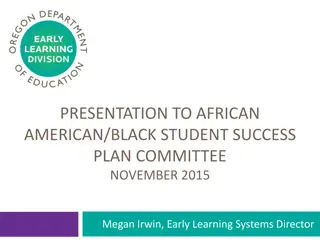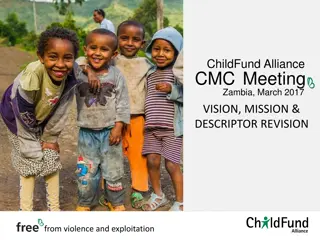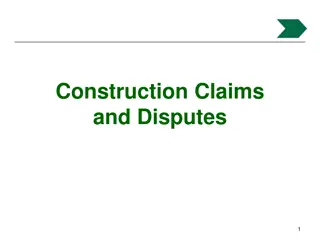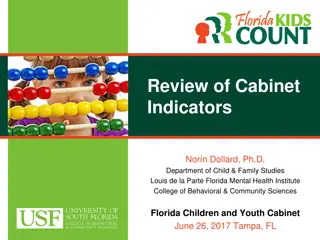Responsibilities & Principles in Children First 2017
The content discusses the importance of upholding responsibilities and principles in safeguarding children, referencing acts and agencies related to child welfare. It emphasizes the definitions of harm, authorized and mandated persons, child safeguarding policies, and procedures. The Child Safeguarding Statement is highlighted as a crucial document to ensure the safety and well-being of children in service settings.
Download Presentation

Please find below an Image/Link to download the presentation.
The content on the website is provided AS IS for your information and personal use only. It may not be sold, licensed, or shared on other websites without obtaining consent from the author.If you encounter any issues during the download, it is possible that the publisher has removed the file from their server.
You are allowed to download the files provided on this website for personal or commercial use, subject to the condition that they are used lawfully. All files are the property of their respective owners.
The content on the website is provided AS IS for your information and personal use only. It may not be sold, licensed, or shared on other websites without obtaining consent from the author.
E N D
Presentation Transcript
2018 1
Responsibilities & Principles in Children First 2017 (and they continue to operate with the Children First Act 2015) 2
National Garda Vetting Bureau (Children and Vulnerable Persons) Act 2012 Criminal Justice (Withholding Information on Offences against Children and Vulnerable Persons) Act 2012 3
Agency means TUSLA a.k.a. The Child and Family Agency. Child as defined under Child Care Act 1991. Welfare includes, in relation to a child, the moral, intellectual, physical, emotional and social welfare of the child. 4
Harm - means in relation to a child: (a) assault, ill-treatment or neglect of the child in a manner that seriously affects or is likely to seriously affect the child s health, development or welfare, or (b) sexual abuse of the child Whether caused by a single act, omission or circumstance or a series or combination of acts, omissions or circumstances or otherwise. 5
Authorised Person: Staff in the Agency appropriate to receive reports. Mandated Person: Persons listed under Schedule 2 of the Act who are required to make reports to the Agency. Clarify through discussion Relevant Service: Work or activity which consists mainly of access to or contact with children Schedule 1. 6
Child Safeguarding Statement Child Safeguarding Policy & Procedures 7
This is a written statement that specifies the service being provided, and the principles and procedures to be observed to ensure, as far as practicable, that a child, availing of the service, is safe from harm. (Children First 2017) See CTC sample developed by P&P project group .. 8
A provider of a relevant service shall furnish a copy of the provider s Child Safeguarding Statement to members of staff, and, on request, to; a parent or guardian of a child availing of the service the Agency members of the public (Section 11) 9
ABC CTC Child Safeguarding Statement Name of service: ABC CTC Nature of service and principles to safeguard children from harm Our Mission: TO RESPOND TO LOCALLY IDENTIFIED INTEGRATED MANNER AND TO PARTICIPATION OF CLIENTS IN THE WORKFORCE & SOCIETY. The purpose of ABC Community Training Centre (ABC CTC) is to provide early school leavers and other disadvantaged and unemployed young people with an opportunity to avail of educational and training opportunities, in a safe environment with the aim of facilitating their social inclusion while supporting the exploration and personal development of the individual. We are committed to safeguarding the children in our care and to providing a safe environment in which they can learn and develop. We are committed to learner centred practice in all our work and full compliance with Children First 2015. We recognise the right of children to be protected from harm, treated with respect, listened to and have their views taken into consideration in matters that affect them. We do this by providing the following services: Risk Assessment We have carried out an assessment of any potential for harm to a child while availing of our services, practices and procedures to mitigate the risk of harm to children while they are participating in the activities of the service. Risk Identified Procedure in place to mitigate identified risk 1. Young person alone with staff member. Safeguarding, child protection and welfare policy 2. Physical Assault/Bullying Equality, Dignity and Respect at work Policy Code of professional conduct Learner code of conduct Recruitment selection and probation guidelines Safeguarding, child protection and welfare policy Learner Induction policy 3. Learner on placement or external Training or residential / Educational Trips (including transport to and from) 4. Internet misuse and Cyberbullying Safeguarding, child protection and welfare policy Information technology, electronic mail and internet policy Policy on learner computer resources and internet usage Policy on learner respect and dignity 5. Risk from public, visitors and external facilitators 6. Failure to follow Child Safeguarding and welfare policy and procedures. Operational Standards for CTCs TRAINING THE NEEDS IN A AND HOLISTIC, ACTIVE PROMOTE EMPOWERMENT Code of professional conduct Recruitment selection and probation guidelines Disciplinary Policy & Procedures for staff & young people Code of professional conduct Recruitment selection and probation guidelines Safeguarding, child protection and welfare policy Operational Standards for CTCs Literacy & Numeracy Counselling Advocacy Code of professional conduct Recruitment selection and probation guidelines Individual Learning Plans Youth Healt Promotion Recruitment selection and probation guidelines Safeguarding, child protection and welfare policy Operational Standards for CTCs ABC CTC Community Based Outreach Work Code of professional conduct Recruitment selection and probation guidelines Safeguarding, child protection and welfare policy Programmes Procedures Our Child Safeguarding Statement has been developed in line with requirements under the Children First Act 2015, Children First: National Guidance for the Protection and Welfare of Children (2017), and Tusla s Child Safeguarding: A Guide for Policy, Procedure and Practice. In addition to the procedures listed in our risk assessment, the following procedures support our intention to safeguard children while they are availing of our service: - Procedure for the management of allegations of abuse or misconduct against workers/volunteers of a child availing of our service; - Procedure for the safe recruitment and selection of workers and volunteers to work with children; - Procedure for provision of and access to child safeguarding training and information, including the identification of the occurrence of harm; - Procedure for the reporting of child protection or welfare concerns to Tusla; - Procedure for maintaining a list of the persons (if any) in the relevant service who are mandated persons; - Procedure for appointing a relevant person. All procedures listed above are detailed in the CTC Employee Handbook and supported by the CTC Operational Standards and are available on request. Learner Information Linked Work Experience Education, Training & Employabiliy Initiatives Learner Participation Principles to Safeguard Children from Harm We in ABC Community Training Centre are committed to working in accordance with the provisions of the Children First Act 2015 and other associated legislation. We are fulfilling our statutory obligations to manage and co-ordinate the implementation of the Children First Act 2015 and, as far as is reasonably practicable, ourselves to ensuring that: We will fully comply with our statutory obligations as a board of management under the Children First Act, 2015 are to: Ensure, as far as practicable that children are safe from harm while availing of the centre s services (i.e. while attending the centre or while participating in centre activities) Carry out an assessment of any potential for harm to children while they are attending the centre or while they are participating in centre activities (this is known as a risk assessment) Prepare and display a written Child Safeguarding Statement in accordance with the requirements of the Act Appoint a relevant person Designated Liaison Person (DLP) as the first point of contact in respect of the centre s Child Safeguarding Statement. Provide a copy of its Child Safeguarding Statement to members of centre personnel and, where requested to parents, members of the public and to Tusla. In accordance with the requirements of the Children First Act 2015, Children First: National Guidance for the Protection and Welfare of Children 2017 and Tusla Guidance on the preparation of Child Safeguarding Statements, the Board of Management of ABC Community Training Centre has agreed the Child Safeguarding Statement set out in this document. The Board of Directors has adopted and will implement fully the Child Protection Policy and Procedures as per Tulsa Children First guidelines and as set out in the CTC Operating Standards and the Employee handbook for Community Training Centres as part of this overall Child Safeguarding Statement Implementation We recognise that implementation is an on-going process. Our service is committed to the implementation of this Child Safeguarding Statement and the procedures that support our intention to keep children safe from harm while availing of our service. This Child Safeguarding Statement will be reviewed by 11th March 2020 or as soon as practicable after there has been a material change in any matter to which the statement refers. Signed: ______________________________ Name: General Manager, ABC CTC Signed: _________________________ Name: Chairperson, ABC CTC For queries, please contact NAME of GM, Relevant Person under the Children First Act 2015 Contact Details: 10
There is provision in the Children First Act 2015 for TUSLA to establish and maintain a register of non- compliance for service providers who: Fail to provide a copy of their Child Safeguarding Statement to TUSLA when requested. 11
In step one you identified policy and procedures already in place to safeguard children from harm. In the next step you need to consider: 1. What your organisation currently has in place, formally or informally, to safeguard children from harm. 2. What your organisation needs to develop to safeguard children from harm. This step will inform your risk assessment. 12
A risk assessment is an exercise where your CTC examines all aspects of your service from a safeguarding perspective to establish whether: there are any practices or features of your service that have the potential to put children at risk of harm (Children First Guidance 2017) 13
Could existing risk management processes be adapted and implemented? Remember - it is risk in relation to Harm Develop templates Information / training Governance & Board arrangements 14
As part of your risk assessment you will name the procedures which are already in place to manage the risks you have identified. 15
Clear procedures must be in place for responding to allegations of abuse made against staff in respect of a child availing of the relevant service. What are the 2 separate procedures to follow? 16
All organisations need to develop appropriate procedures for appointing a relevant person including name and contact details. A relevant person is the first point of contact in relation to the Child Safeguarding Statement. So in your CTC who is that? 17
Reporting procedures must be in place that are in line with the Children First Act 2015 and with Children First National Guidance 2017 The reporting procedures for staff must take into account mandated persons and those who are not mandated persons. Discuss . 18
For the purpose of your CSS, you are required to develop a procedure for maintaining a list of mandated persons. Identify how many mandated persons are in your service Are they aware that they are mandated persons? Role and function 20
Section 14: Mandated persons: Legal obligation on certain people, many of whom are professionals, who have contact with children and/or families and, because of their qualifications, training and/or employment, are in a key position to help protect children from harm. (Children First Guidance 2017) Children First Act 2015, Schedule 2 In a CTC context these are, for example, Teachers under your hours in co-operation service from ETB 21
Legal obligation to report: Where a mandated person, knows, believes or has reasonable grounds to suspect that a child is being harmed, has been harmed or is at risk of being harmed, they must report that belief or suspicion to the Authorised Person within the Agency Section 14(1). (Also pertains to where a child discloses to a mandated person) So in a CTC what happens with DLPs? 22
Section 14 (3): A mandated person shall not be required to make a report to the Agency where : He or she knows or believes that: a child aged 15 years or more but less than 17 years is engaged in sexual activity, and the other party is not more than 2 years older than the child concerned, and the relationship between the parties is not intimidatory or exploitative of either party, and the child concerned has made known to the mandated person their view that such activity should not be reported to the Agency and the person relied upon that view. 23
Sharing of information and assessment of reports (Section 17): The Agency may share information concerning a child with a mandated person which is necessary and proportionate to the case. Criminal offence to disclose information to 3rd party without permission of the Agency. 24
What are the challenges for you in your role and for your CTC? 25
Who will lead the process? o Who is the provider? o Who is the relevant person? o Who is the mandated person/s? What relevant services do you provide to children within your organisation? Who are the stakeholders? How will you assess risk of harm to a child? What child safeguarding policies and procedures are already in place? What additional procedures need to be developed? Finally Consider: o o Implementation strategy Process for oversight and quality assurance 26


